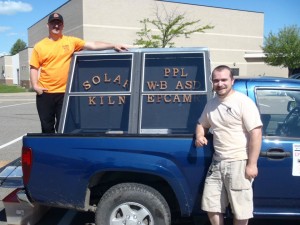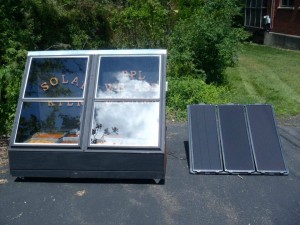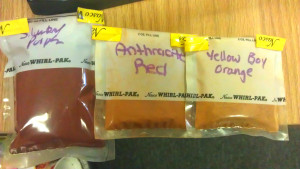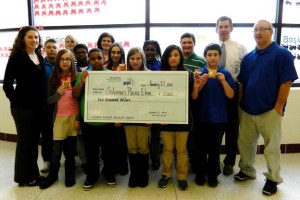EPCAMR’s “Mobile Solar Kiln for Processing and Recycling Oxides from AMD” project recently won 1st Place and a $500 donation at the Non-Profit Community Assistance Center (NCAC) Annual Community Awards Dinner on June 11, 2015 at the Hilton Hotel in Scranton, PA. This dinner was a wonderful opportunity for EPCAMR to network with regional community foundations and highlight our organization’s mission and accomplishments. EPCAMR was nominated in the Environmental Action category. EPCAMR is the first nonprofit organization in the Anthracite Region to design and construct the first solar-powered kiln for drying oxides found in Abandoned Mine Drainage (AMD).

In 2012, EPCAMR built a large mobile kiln for demonstration purposes in environmental education programs to showcase how oxides can be recycled from AMD. Funds were donated to EPCAMR by the Wilkes-Barre Area School District after the kiln construction to continue to use at other local school districts. This kiln and another smaller kiln, built for the Solomon-Plains Elementary School, has allowed EPCAMR to educate elementary students across the EPCAMR Region. The reason for the design was due to the need for a more efficient way of drying metal oxides collected from local mine drainage that is then utilized for education programs to make AMD Tie-Dye t-shirts, Iron oxide chalk, and paint pigment and wood stain for local artists. This project brings EPCAMR a bit off the grid by reducing the utilization of a soil oven, which consumes a fair amount of electricity to dry the oxides for only a small amount of dried oxide.
EPCAMR Program Manager, Mike Hewitt, designed a system that relieves the oven process. The solar kiln runs off of a 45-watt solar panel system and is made out of mostly recycled materials: motorcycle battery, 12 volt computer fan, single pane storm windows, T-111 wooden siding, and 2x4s. The computer fan is run by the solar panels to remove any excess moisture within the kiln. The inside of the kiln is painted black to absorb as much heat from the sun as possible. The larger kiln is approximately 4′ x 6′, with two hinged doors in the back for loading in the oxides. It rolls on wheels for easy outside access. The solar kiln can dry 8 cake pans at one time, as compared to the two cookie sheets the oven can dry at one time. Within 4 hours, on an 80 degree day, the kiln can reach an inside temperature of 120 degrees. The solar kiln can dry 40 pounds of oxides a day, as compared to 1 pound a day using the oven.

EPCAMR places hydroxides that are about 95% liquid rust into the cake pans and allows for the heat energy to dry them naturally. EPCAMR Staff, interns, and volunteers then sifts the oxide powder to remove any leaf litter or sticks and packages it up to be sold through the EPCAMR Online Store. Proceeds from the Store support our education and outreach programs as well as general operations of the organization.
The smaller solar kiln was provided to the Solomon-Plains Elementary School, who are consistently taking part in environmental programs with EPCAMR. There is a great need for environmental education for students within the Wilkes-Barre School District, who are among the lowest poverty level in Luzerne County, PA. The students can now dry and process their own oxides for when EPCAMR comes to conduct education programs. Other local schools, including Greater Nanticoke Area Elementary and Wilkes-Barre Area Elementary, have also seen the solar kiln in action.
A novelty of this project is that it uses zero use of electricity for the project, unless we produce pigments of Anthracite Red or Silverbrook Purple, which need to be dried in the soil oven after the solar kiln in order to get their darker hues. EPCAMR estimates the electricity used to power the soil oven costs approximately $120/year, just to dry the oxide from the Yellow Boy pigment to Anthracite Red. It costs EPCAMR nothing to utilize the solar kiln to dry the oxide to Yellow Boy.

AMD Pigments
The EPCAMR “Mobile Recycled Solar Kiln for Processing and Drying Oxides from AMD” project was funded by the PPL Empowering Educators Grant, in partnership with the Wilkes-Barre Area School District, PA DEP Environmental Education Program, Earth Conservancy, King’s College Environmental Club, Lowe’s, RESTORE, Appalachian Coal Country Team, Office of Surface Mining, and AmeriCorps Volunteers in Service Training for America.
The program involved EPCAMR Staff and interns from King’s College and Wilkes University assisting with the collection of oxides and construction of the solar kilns. Earth Conservancy provides us with the storage for the kiln and access to their AMD treatment systems in Nanticoke and Newport Township for oxides. The Solomon-Plains Elementary 6th grade class and their teachers participated in outdoor field tours with EPCAMR to AMD sites before utilizing the kiln. The students made AMD tie-dye t-shirts for their field trip with the dried Iron oxide they collected on a tour with EPCAMR and have made it an annual tradition that is 3 years strong. More recently, the Greater Nanticoke Area Elementary 4th and 5th grade classes got to see the solar kiln and utilized the Iron oxide from through EPCAMR’s AMD & Art Pottery Education program. Ann Devine and two interns from the PA DEP Environmental Education Program conducted a Solar Race Car Construction Workshop at Solomon-Plains Elementary. Alana Malar Roberts, former PPL Community Relations Coordinator, was was also instrumental in the project.
EPCAMR’s objective was to create a demonstration piece of equipment that would provide under-served elementary school students within the Coal Region the ability to dry Iron oxide from AMD on their own. There were two goals: 1) to go off the grid and be 100% solar and 2) provide students with an opportunity to learn about AMD impacts to their watersheds and find ways to recycle the oxides into many productive uses that are fun and “green”. The benefits of this projects are that students are engaged and introduced to Science, Technology, Engineering, & Math (STEM) principles that meet the PA Standards for the Environment and Ecology.

Students gather with PPL, EPCAMR, and WBAD at Solomon-Plains Elementary to receive grant check
EPCAMR has always been committed to restoring Pennsylvania’s waterways impacted by AMD and abandoned mine lands. EPCAMR plans to build a 3rd solar kiln in the Fall of 2015 with the remaining materials we have left over from the project and provide it to Heights Elementary. This project educates not only students, but teachers on how schools can be a part of the solution by working with EPCAMR. They will be provided with environmental education experiences on local environmental issues that impact their community directly. They will also learn about environmental stewardship and ways they can get involved in stream-side cleanup.












You must be logged in to post a comment.